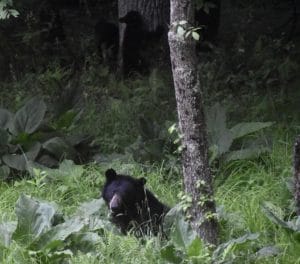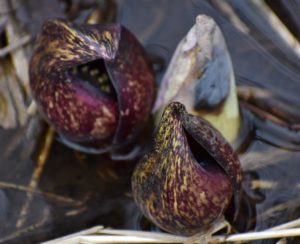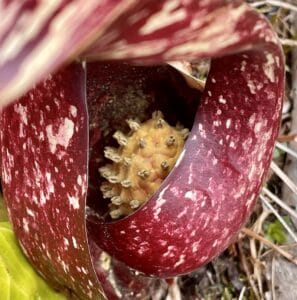Hello fellow readers, Skunk Cabbage arrived late this year. Its unusual chemistry creates heat, melting the snow around itself, and is typically one of the first things to sprout in March. This year’s deep and late snow cover gave it a slower start. Despite its fragrance, skunk cabbage has a remarkable appeal.
Skunk cabbage serves a purpose long ago as well as today.

Our visiting Momma Bear
Rumor has it that black bears emerge from hibernation when skunk cabbage sprouts. I thought the correlation was that bears eat skunk cabbage. It turns out they do, but only in early spring before there are better things to nosh on. Skunk cabbage leaves are filled with oxalic acid, the same stuff in rhubarb leaves. But a black bear eats about anything when rousing from hibernation and will look beyond the burning sensation felt when eating skunk cabbage.
Native American Indians used it for medicinal purposes. Today, sold as a tincture, skunk cabbage root is used as an expectorant for nasal congestion and hay fever, though the FDA has not evaluated it.
Skunk cabbage in the garden?
I’m not the only one who admires how skunk cabbage carpets stream banks and low-lying woodland floors before the surrounding tree leaves emerge. Brian of Washington Township, NJ, asked if he could use it in the garden. I’ve often thought it would make an excellent option in place of hosta, deer candy, as most of you know. But unlike hosta, it grows in swampy, often stagnant water, so the cultural environments are different. But indeed, in a boggy garden, skunk cabbage has an appeal.
It would be tough to dig and move skunk cabbage as their deep roots grow deeper as they grow older, making it practically impossible to dig up older plants. I’ve never seen Symplocarpus foetidus in a nursery, either. Inevitably, as the common name denotes, its smell can be offensive, especially if cut by a weed whacker or stepped on. But walking by a field of skunk cabbage has only a slight musty smell other than the flower. It’s fascinating how early pollinators find the flower appealing, which smells much like a dead animal. So like most things, it’s all a matter of taste.
Garden Dilemmas? AskMaryStone@gmail.com (and your favorite Podcast App.)
Column updated 7/24/22
To learn about rhubarb, which shares the common thread of oxalic acid with skunk cabbage, click Rhubarb Edible vs. Ornamental.
And, you can tune into the podcast version of this story

Interesting tidbit: Skunk Cabbage is listed as endangered in Tennessee.





